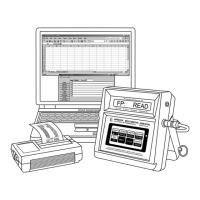ADM-870C 07/14/0957
APPENDIX C - BATTERY TEST PROCEDURE
Insufficient battery charge (entire set or individual cells) can cause the meter to display garbled messages or TOO HOT, TOO
COLD, RECHARGE or other messages. This garbled display usually is seen when the meter is just turned on and the supply
voltage drops so fast that the meter gets lost. The following tests should be performed before you call the manufacturer or
return the meter.
1. Check the battery charger transformer. The output should be 24 to 30 volts AC. Be sure the charger is plugged into
a live outlet. The green LED on the front panel indicates when the battery charger is powered.
2. Does the meter function properly while the charger is attached and plugged-in? If so, a bad battery cell is likely. Allow
ten minutes for minimum charging to take effect before testing meter function.
3. Place the meter face down with the air connectors turned away from you. Remove the battery compartment cover by
unscrewing the eight small phillips head screws. Check the battery clips. Remove the batteries and re-spring the clips
to provide proper contact pressure with the ends of the batteries.
Be sure to reinstall the batteries in the proper orientation as shown in the compartment. Turn the meter on to see if
the problem display still exists. If the problem persists, test the positive (+) and negative (-) charging circuits as follows:
a. Measure the DC voltage of the upper half [positive(+) six cells] of the battery set by placing your DC voltmeter
common (ground) probe at the left center battery clip and the other probe at the upper right corner battery clip.
The voltage should be between 7.2 volts and 8.5 volts DC.
This voltage should rise when the charger is plugged in and should fall when the charger is unplugged.
b. If the voltage does not rise and fall with the changes in charger input, then the charging circuit in the meter is
not working and the meter must be returned to the factory for repair.
c. Test the lower half [negative (-) six cells] of the battery set in the same manner described above by placing the
voltmeter probes at the left center battery clips and at the lower right corner battery clip.
4. Check each battery cell voltage with the charger unplugged and with the meter turned on (if it will stay turned on).
Each cell should have a voltage of 1.1 to 1.3 volts. If you find one or two very low cells, they may be weak cells and
may need to be replaced. If most of the cells are less than 1.1 volts, it is possible that all are near the end of the
discharge cycle and just need to be recharged.
5. Replace weak or low capacity battery cells with rechargeable cells of the same capacity (mAh) as the existing cells.
If the same capacity cells are not available, replace all 12 cells with new batteries. See the Instruction Manual Section
15.0 METER MAINTENANCE.
6. If the problem is not corrected through these procedures, please return the meter to our factory for repair and
calibration services.
PROLONGING BATTERY LIFE
The NiCad “memory effect” occurs when batteries are only partially discharged and recharged repeatedly. This effect
substantially reduces the level of useable charge in the batteries. The batteries can be restored to maximum usable capacity
by discharging the batteries until the meter displays RECHARGE at least once a month. This can be accomplished at the
end of the work week by running the meter continuously until the batteries run down. The meter will remain on if left in
TREND mode. The back-light should be off during the discharge period. The meter will shut off automatically when
RECHARGE is displayed. Place the meter on charge for at least 24 hours, so the meter will be fully charged for the next
week's work.
Long term storage of batteries can temporarily degrade their performance. If the meter is to be stored without being used
for at least three months, discharge the batteries as described above. The temperature during storage should be less than
95
/ F. The batteries will function best after storage if reconditioned by performing two full cycles of 24 hour charge and full
discharge, followed by a third 24 hour charge. This process will restore the batteries to maximum usable capacity.
WARNING: Do not plug in the charger if ANY nonrechargeable batteries are in the meter.

